1 Introduction
Energy, environment, and climate change have become major challenges globally.On May 14, 2017, President Xi Jinping delivered a keynote speech at the opening ceremony of the Belt and Road Forum for International Cooperation proposing “to seize opportunities presented by the new round of change in energy mix and the revolution in energy technologies to develop GEI and achieve green and lowcarbon development.” This is the second time President Xi Jinping proposed to develop GEI in the international arena, following the speech at the UN Development Summit on September 26, 2015, which proposed discussions on establishing GEI, to facilitate efforts to meet global power demand with clean and green alternatives [1-4].
In March 2016, China initiated the establishment of the GEI Development Cooperation Organization, which released three documents in February 2017: Global Energy Interconnection Development Strategy White Paper, Transnational Intercontinental Grid Interconnect Technology and Outlook, and The Global Energy Interconnection Development and Prospects (2017).They provide an in-depth analysis of current status of global clean energy, grid technology, and cross-border interconnection development and proposes the GEI development strategy system, development ideas, and strategic priorities.
In recent years, renewable energy power generation, represented by wind power and photovoltaic power generation, has been greatly developed in China.Currently, China has become the country with the world’s largest installed capacity of wind power and photovoltaic power generation.By the end of 2019, the total installed capacity of wind power and photovoltaic power generation in China has exceeded 400 GW.Driven by relevant policy support, China’s renewable energy power generation technology has matured and improved [5-7].The cost of energy production has continuously reduced, and the market competitiveness has continuously enhanced, laying an important foundation for the large-scale application of renewable energy and the greater interconnection of power grids in the future [8].
Based on a comparative analysis between China and global renewable energy resources distribution and development scenarios, this study focuses on the achievements, challenges, and solutions of China renewable energy development, aiming to provide a reference for developing the GEI.
2 Similarity analysis of China and global renewable energy development scenarios
2.1 Comparison of resource distribution of renewable energy in China and the world
Wind and solar resources of China are concentrated in the western and northern regions.Among them, the “Three North” regions (Northeast, Northwest, and North China) account for more than 90% of the wind energy resources of China.The solar resources located in the western and northern regions account for more than 80% of the solar resources of China.Approximately 80% of the hydropower resources of China are distributed in the southwestern region; Tibet, Sichuan, Yunnan, and Qinghai are rich in water energy resources.While the electrical load of China is mainly concentrated in the eastern and central regions; on the contrary, the distribution of renewable energy resources are concentrated in the northern and western regions [9].
Globally, regions with wind power densities exceeding 400 W/m2 are mainly concentrated in the Arctic Ocean, central North America, southern South America, Australia, Central Asia, West Asia, and China’s “Three North”.Moreover, Regions with the total annual solar radiation exceeding 1,700 kW・h/m2 are mainly distributed in the energy zone that is 45° from the equator [10].From the perspective of energy supply and demand distribution in a worldwide range (such as Asia-Africa-Europe), global renewable energy resources and loads do not match, as shown in Fig.1.Only local areas (such as Europe) have good renewable energy and load matching, which can achieve local consumption and utilization, as shown in Fig.2.
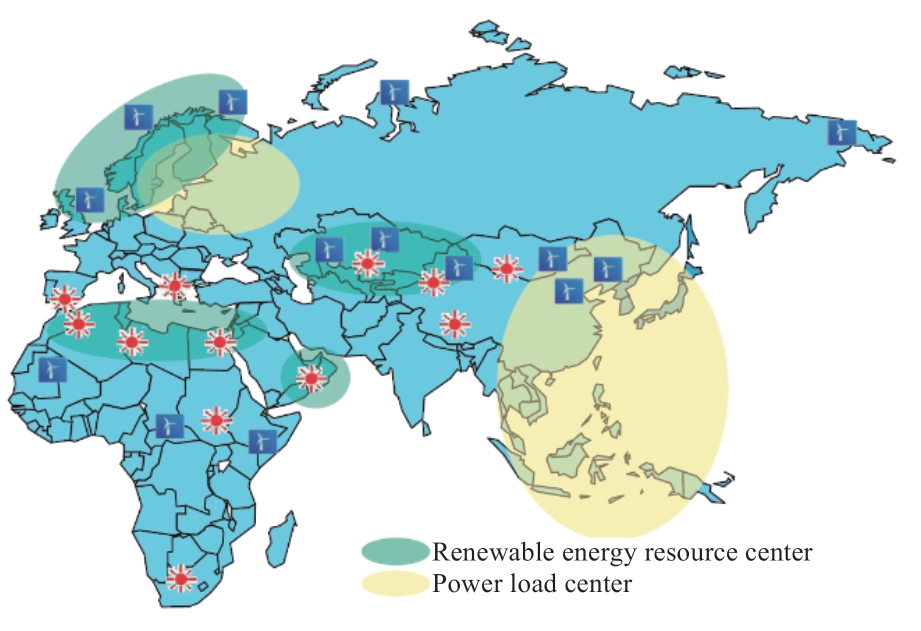
Fig.1 Distribution of renewable energy supply and demand in Asia-Africa-Europe
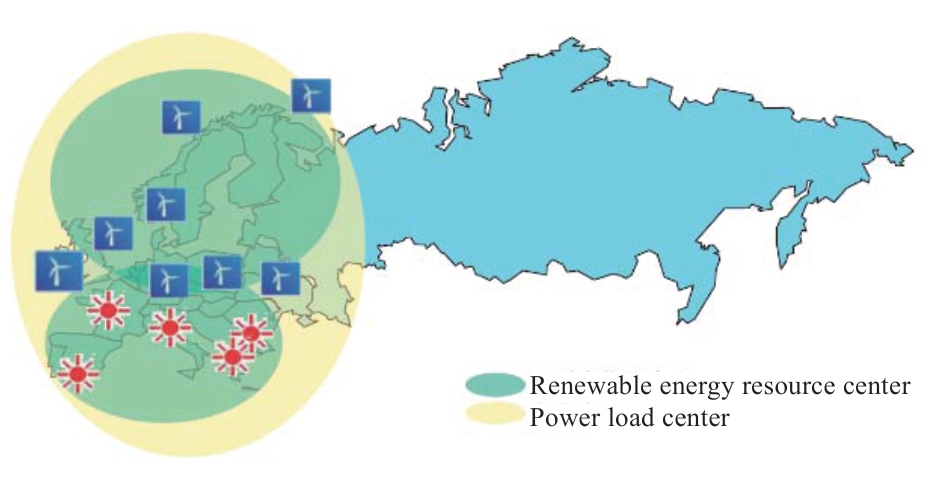
Fig.2 Distribution of renewable energy supply and demand in Europe
2.2 Comparison of the status of utilization of renewable energy in China and the world
The cumulative installed capacity of renewable energy in China from 2014 to 2018 is shown in Fig.3.By the end of 2018, the cumulative installed capacity of wind power reached 184 GW, accounting for 9.7% of the total installed capacity, mainly distributed in the “Three North” area.The top five provinces (autonomous regions) with installed capacity are Inner Mongolia (28.69 GW), Xinjiang (19.21 GW), Hebei (13.91 GW), Gansu (12.82 GW), and Shandong (11.46 GW).The cumulative installed capacity of photovoltaic power generation is 174 GW, of which the installed capacity of photovoltaic power plants is 123.8 GW, the distributed installed capacity is 50.6 GW, accounting for 29%.The top five provinces (autonomous regions) with photovoltaic power installed capacity are Shandong (13.61 GW), Jiangsu (13.32 GW), Hebei (12.34 GW), Zhejiang (11.38 GW), and Anhui (11.18 GW).

Fig.3 China’s renewable energy cumulative installed capacity from 2014 to 2018
The cumulative installed capacity of hydropower is 350.0 GW, accounting for 18.4% of the total installed capacity [11,12].
In 2018, the generation capacities of wind power, photovoltaic and hydropower of China were 366.0 TW·h, 177.5 TW·h, and 1,230 TW·h, respectively.During the 12th Five-Year Plan period, the annual growth rate of wind power, photovoltaic and hydropower generation of China were 30%, 219%, and 18%, respectively, having a growth rate of 28.7% points higher than the national power generation growth rate for the same period.The proportion of wind power and photovoltaic power generation increased from 0.7% and 0.003% in 2010 to 5.2% and 2.5% in 2018, respectively.The proportion of hydropower generation decreased from 22.18% in 2010 to 17.6% in 2018 [13].
In 2018, the cumulative installed capacity of the global renewable energy power generation was 2,351 GW representing an increase of 7.9% year-on-year, accounting for one-third of the total installed capacity of power generation in the world; China ranks first with 708 GW, and EU and USA rank the second and third with 446.4 GW and 245.2 GW, respectively [14].Moreover, the global installed capacity of renewable energy in 2018 is shown in Fig.4.

Fig.4 Main countries with a large capacity for renewable energy in 2018
2.3 Development scenario similarity analysis
In summary, the trend of renewable energy development in China and the world are the same.In the future, to achieve a clean energy transition, in the near, medium, and long-term energy planning in China and worldwide, the installed capacity of renewable energy should continue to grow at a high speed to achieve a gradual transition from supplementary power to main power.
Meanwhile, from the perspective of spatial distribution, most of the China and global renewable energy bases are inversely distributed with load-concentrated areas, and only a small number of areas can achieve small-area local balance.The ratio of the installed capacity renewable energy of China to the maximum load (i.e.renewable energy penetration) is 22%, higher than the US (10%), lower than Denmark (93%), Spain (78%) and Portugal (63%).Thus, the ratio is at a medium level; however, for Eastern Inner Mongolia, Gansu, Ningxia, Xinjiang, and other regions the ratio is above 100% [7].Therefore, the current difficulties in developing renewable energy in China will also be encountered in the future construction of the GEI.
3 Major achievements and challenges of China’s renewable energy development
In January 2006, the Renewable Energy Law of the People’s Republic of China was officially implemented.Subsequently, China formulated a series of measures such as feed-in tariffs for renewable energy power generation, financial subsidies, tax incentives, concessional loans and priority connection to the grid, forming a systematic policy framework for renewable energy development.Meanwhile, the relevant technical standards, and specifications such as Technical rule for connecting wind farm to power system were revised to address the technical issues in terms of renewable energy grid integration.These policies, measures, and standards guide promote the health and sustainable development of renewable energy in China.
3.1 Exploring renewable energy resource reserves and distribution
Since the 1970s, China has conducted four surveys of wind energy resources, and gradually found out the development potential and distribution of wind energy resources.Owing to the technological advances and the refinement of resource survey, the technical development potential of the wind energy resources of China increased from 253 GW in the late 1980s to 3.9 TW in 2018 (including 500 GW low wind speed resources).The Qinghai-Tibet Plateau in western China, northern Gansu, northern Ningxia and southern Xinjiang have the most abundant solar resources, with an annual development potential of more than 85,000 TW·h.If developing solar energy in areas with a slope of 3° or less is prioritized, Xinjiang has the largest annual development potential of approximately 1970 TW·h; if developing solar energy in areas with a slope of 6° or less is prioritized, the annual development potential of Xinjiang is also the largest, approximately 2300 TW·h.
3.2 Centralized and distributed development
Renewable energy development of China has adopted a centralized and distributed development model.As the load centers of China are mainly distributed in the eastern and central provinces, large-scale development of renewable energy requires cluster development, and long-distance transportation mode.For instance, UHV transmission technology [15] is used to transport wind power and solar power in the “Three North” region and hydropower in the southwest to the load center over long distances.With this consideration, China has been constructing renewable energy power generation bases and related UHV transmission projects in the 13th Five-Year-Plan period.Some of them are summarized in Table 1.
Table 1 Renewable energy bases and transmission projects
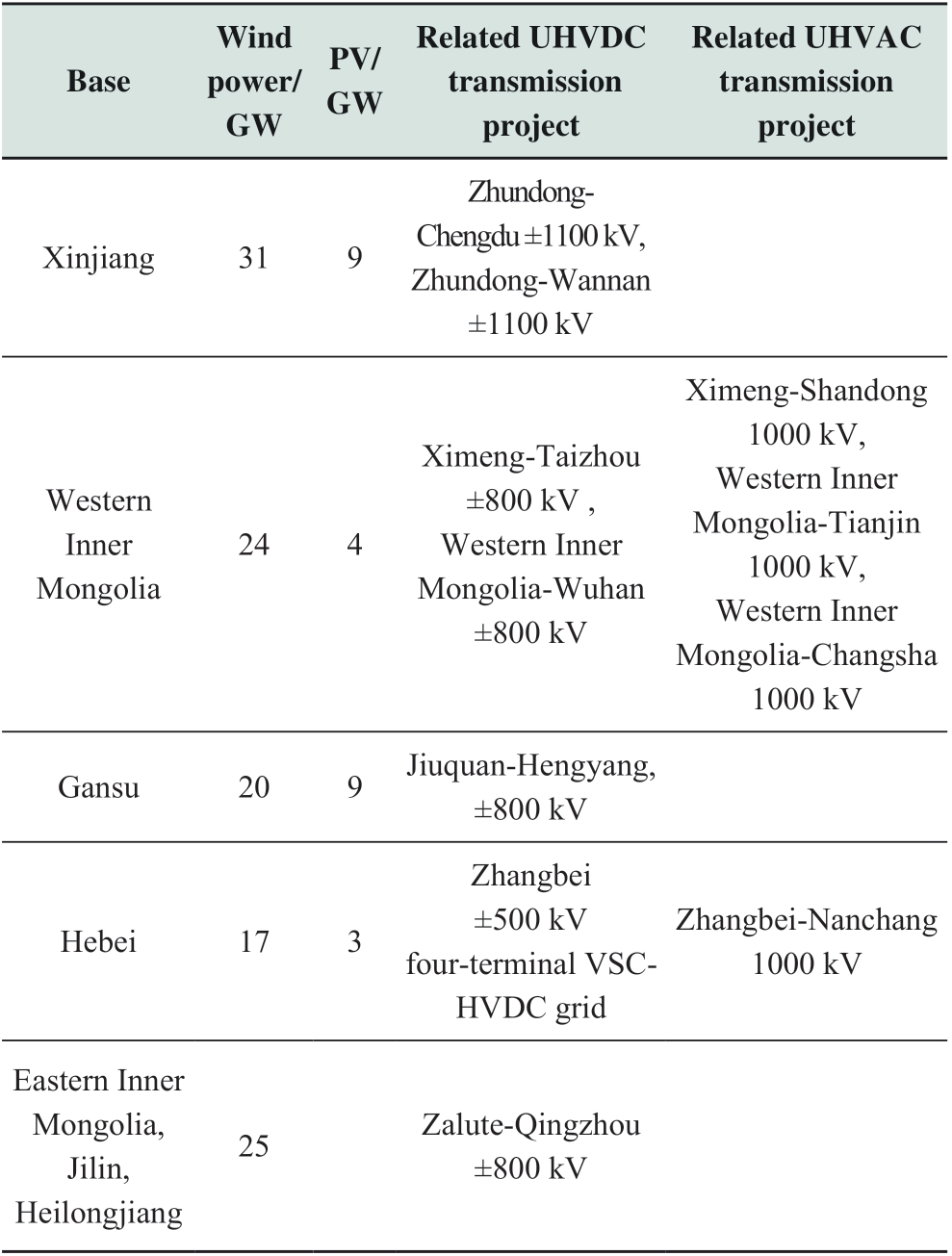
In the eastern, central and southwestern parts of China, renewable energy resource endowments and power demand are well matched.Thus, the main development direction is to decentralize wind power and distributed photovoltaic power generation, combined with a distributed power grid and microgrid, to achieve local balance of power generation-transmission-comsuption.By the end of 2018, the top three provinces in China with distributed photovoltaic power generation installed capacity were Zhejiang (7.76 GW), Shandong (7.13 GW) and Jiangsu (5.4 GW).And the number of grid-connected distributed photovoltaic power generations in the operating area covered by China State Grid Corporation in 2017 reached 464.76 thousand households, which represents an increase of 210% over 2016.According to the 13th Five-Year Plan for power development of China, during the 13th Five-Year Plan period, China will fully promote developing distributed photovoltaic power generation.By the end of 2019, the grid-connected capacity of distributed photovoltaic power generation has exceeded 60 GW.
3.3 Strong smart grid support
Driven by the growth of power demand, technological innovation and the rapid development of renewable energy, China Power Grid has entered a new era marked by a strong smart grid.This grid is a new modern power grid with the UHV grid as its backbone and coordinated grid development at all levels.“Strong” and “smart” are the basic requirements for the future power grid.“Strong grid” is the foundation" and “intelligence” is the key, which are indispensable.The strong smart grid features compatibleness with the power generation side, robustness on the transmission side, and flexibility on the power side; further, the grid has the openness of technology upgrade, which can satisfy the access of multiple energy sources and solve the accommodation and security issues of renewable energy grid integration.
Fig.5 depicts a smart grid development-supporting renewable-energy schematic diagram.The key technologies of an smart grid include: renewable energy power generation virtual-synchronous-machine technology, VSC-HVDC transmission technology, large-scale AC-DC hybrid power grid security and stable operation control technology, largecapacity energy storage technology and distributed microgrid technology, and the deep integration of grid with cloud computing, big data, Internet of Things, mobile Internet technology.With the increasing development of renewable energy, the benefits of a strong smart grid’s large-scale energy resource allocation and safe economic operation will be more significant, providing a basis for the efficient use of large-scale renewable energy.
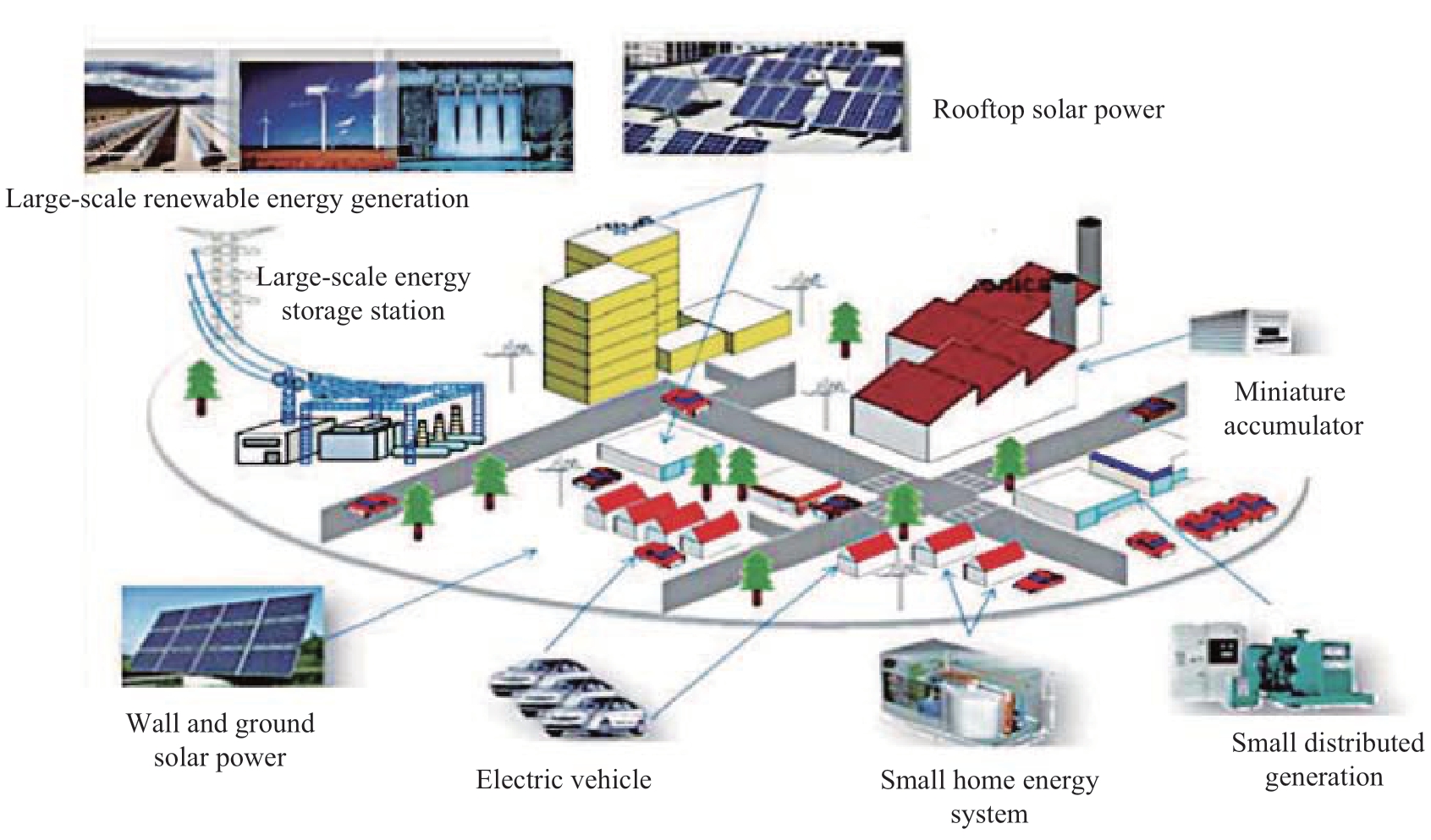
Fig.5 Smart grid development-supporting renewable-energy
3.4 Renewable energy power generation equipment manufacturing and operation
The wind power equipment manufacturing industry and the solar photovoltaic module manufacturing industry of China have developed rapidly.Among the top ten wind turbine manufacturers in the world in 2018, Chinese companies accounted for 4, with a total market share of 29.32%.In 2018, polysilicon production in China was approximately 259,000 tons, accounting for 60.2% of worldwide output.Furthermore, photovoltaic module production was approximately 85.7 GW, accounting for 63% of global production, staying first for ten consecutive years.
With decreasing equipment manufacturing costs and improving technologies such as model design, micro-site selection, and operation and maintenance level, the cost of wind power and photovoltaic power generation continues to decline.The levelized cost of energy (LCOE) of onshore wind power has been reduced from 0.5~0.6 yuan/kW·h in 2010 to approximately 0.32~0.46 yuan/kW·h in 2018.In 2013, the LCOE of large-scale ground photovoltaic power plants in western China was 0.7~0.9 yuan/kW·h, and that of photovoltaic power generation in the eastern region was 0.9~1.2 yuan/kW·h.In 2018, the LCOE of photovoltaic power generation has fallen to 0.377 yuan/kW·h [16].By 2021, the onshore wind power generation in China can achieve parity in an all-around way, laying a solid economic foundation for energy clean transition.
Through technological innovation and equipment upgrades, the unit capacity, reliability, and power generation performance of the renewable energy power generation equipment have been continuously improved.The grid-frendliness of wind farms and photovoltaic power plants has been continuously enhanced, with the capabilities of voltage/frequency control, high/low voltage fault ride-through, and accurate electricity and power prediction, etc., which provides technical support for the safe and stable operation of the power grid.
3.5 Wind power and photovoltaic power curtailment
In 2018, wind power curtailment in China reached 27.7 TW·h, with an average curtailment rate of 7%.The curtailment rates in Xinjiang, Gansu, and Inner Mongolia were as high as 22.9%, 19.0%, and 10.3%, respectively.In 2018, solar power and hydro power curtailment in China were 5.5 TW·h and 69.1 TW·h, respectively.Obviously, the total renewable energy power curtailed in a year exceeds 100 TW·h , which has aroused wide public concern.
The power generation, supply, and consumption are completed simultaneously and instantaneously balanced.The output of renewable energy such as wind and solar has randomness and volatility.With a high proportion of renewable power connected to the power system, more flexible resources are needed to balance the generation and power demand.The conventional power source needs not only follow the load change, but also balance the fluctuation of renewable energy power generation.When the output of renewable energy generation fluctuates beyond the regulation range of the power system, it is necessary to control the output to ensure the balance of the system, which will cause wind and solar curtailment.
At present, China lacks a mechanism for the coordinated and complementary development of renewable energy and other energy sources.It has not established a solid and effective power and industrial planning, grid operation, and power market mechanism to ensure the priority utilization of renewable energy.From a technical perspective, there are three main reasons for wind and solar power curtailment in China:
(1) Uncoordinated development between grid, power sources and power markets.
Grid interconnection is the physical support for largescale energy resource allocation.The comprehensive power planning in China has been lacking over the past decade.Although various power source and power grid plans have been formulated, there was still a lack of unified coordination and balance, resulting in that the development of power source and power grid are not in the same pace.Power demand in the eastern provinces is growing at a high speed.While the surplus wind power, photovoltaic power, and hydropower in the “Three North” and southwestern regions cannot be trans-regionally delivered due to the network constraints.Furthermore, as an effective national power market mechanism has not yet been established, the power generation plan is formulated by local governments.Provinces give priority to local power plants, and the willingness to import renewable energy from other regions is weak, which objectively increases the difficulty of the trans-regional renewable energy consumption.
(2) Insufficient flexibility of power sources.
Power supply structure in China is dominated by coalfired power with basic load, while the proportion of flexible power supply is low.The thermal power installed capacity accounts for 67% of the national power supply capacity, and the proportion of flexible power supply such as pumped storage and gas is only 6%; the flexible regulation capability is inherently insufficient.Thermal power units, particularly the combined heat and power (CHP) units, have poor regulation capabilities.The “Three North” area has a large proportion of CHP units, and the proportion of heating units in 10 provinces (autonomous regions) exceeds 40%.Furthermore, the proportion of enterprise owned power plants in some areas is high, and the enterprise owned power plants do not participate in peak shaving and frequency regulation.By the end of 2016, the installed capacity of enterprise owned power plants in the “Three North” area reached 82.31 GW, accounting for more than 19% of the local thermal power installed capacity, 1.5 times more than that of 2010, of which 7 provinces’ (autonomous regions’) enterprise owned power plants accounted for more than 10% of the province’s thermal power installed capacity.
(3) The renewable energy base has insufficient capacity for local energy consumption.
The proportion of the “Three North” regoin and Southwest China economic development and terminal electricity consumption of China is behind the national average.In 2018, the “Three North” region’s and Northwest China’s power load accounted for only40.9% and 9.7% of China’s total power load respectively, but concentrated 71.58% of China’s wind power installed capacity and 23.9% of China’s solar power installed capacity, resulting in a huge mismatch between the power generation and power load.Power consumption is heavily dependent on the construction and operation of UHV transmission corridor.This issue will gradually be alleviated in the future with the structural adjustment and balanced development of China’s regional economic development.In recent years, China has taken many measures simultaneously.The situation of renewable energy accommodation continues to improve.In 2019, China’s wind and photovoltaic power curtailment rate are 3.8% and 2.2% respectively.
4 China’s renewable energy sustainable development measures
Key factors affecting developing renewable energy have to be addressed to ensure the large-scale development and efficient accommodation of renewable energy.These factors are grid interconnection, power regulation performance, demand side management, and power market.
4.1 Expanding the range of renewable energy power consumption and balance
As renewable energy resource center and load center in China are reversely distributed, it is necessary to build a national interconnected grid and interconnection platform to achieve temporal and spatial complementarity between regions and multiple power sources.With the larger-scale development of renewable energy, it is necessary to plan and construct corresponding trans-regional UHV AC and DC transmission projects [17].Furthermore, it is necessary to form an energy resource optimization allocation platform with reasonable structure, strong and robust grid, wide interconnection, and intelligent dispatch and control.Meanwhile, in the central and eastern regions, distributed renewable energy should be actively developed, combined with the development of microgrid, to reform the energy structure of the region.The complementary coordination of renewable energy should be achieved, and the overall efficiency of large-area energy systems should be effectively improved along with its capability to accommodate renewable energy.As the power grid is widely connected, various renewable energy generation time and space complementarities are utilized.Thus, their respective power generation cluster outputs are complemented and balanced in a large area and the volatility of the comprehensive output is reduced.Utilizing the two-way interaction between the smart grid and distributed power sources and new end-users (such as electric vehicles) to help solve the peak shaving problem of the power grid.As shown in Fig.6, the output power of a regional wind power cluster system can be stated that the larger the balancing area of the multi-energy system, the smaller the time fluctuation of the output.
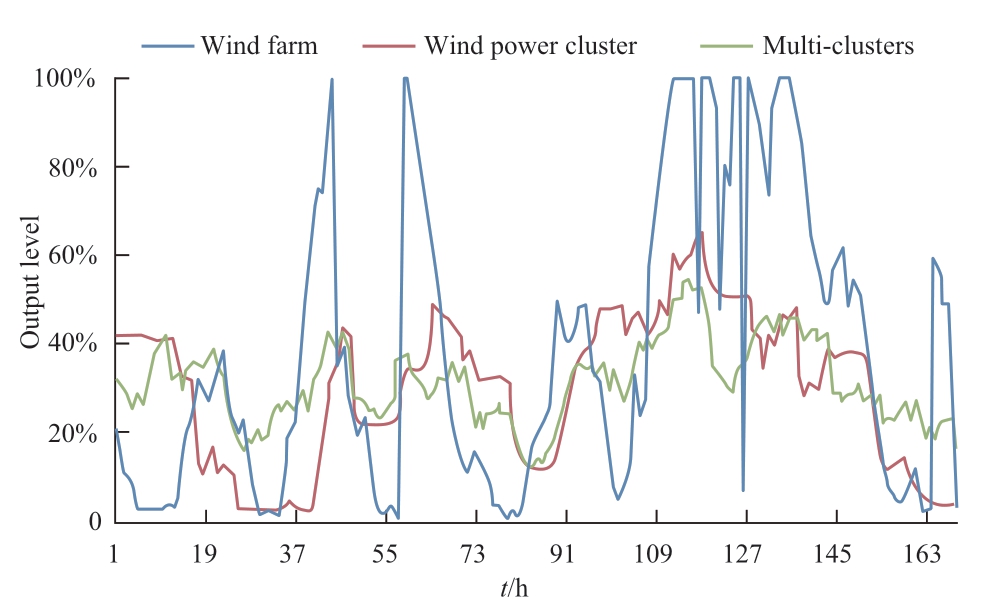
Fig.6 Temporal and spatial characteristics of wind power output
Based on the simulation calculation of the heating period in the northeast region, under the local balance mode with fixed inter-provincial tie-line power, the cumulative wind power curtailment is 4.632 TW·h, and the wind curtailment rate is 25.2%.After optimizing the inter-provincial tie-line power, the transmission power varies following the change of wind power and power load, and the total transmission electricity remains the same, wind power is accommodated in the large area.The wind power curtailment in the northeast China is reduced to 3.106 TW·h, and curtailment rate is reduced to 17.32%, which is reduced by 8 %, as shown in Fig.7.This case indicates that scaling up the balance area can significantly improve the capability of renewable energy accommodation.
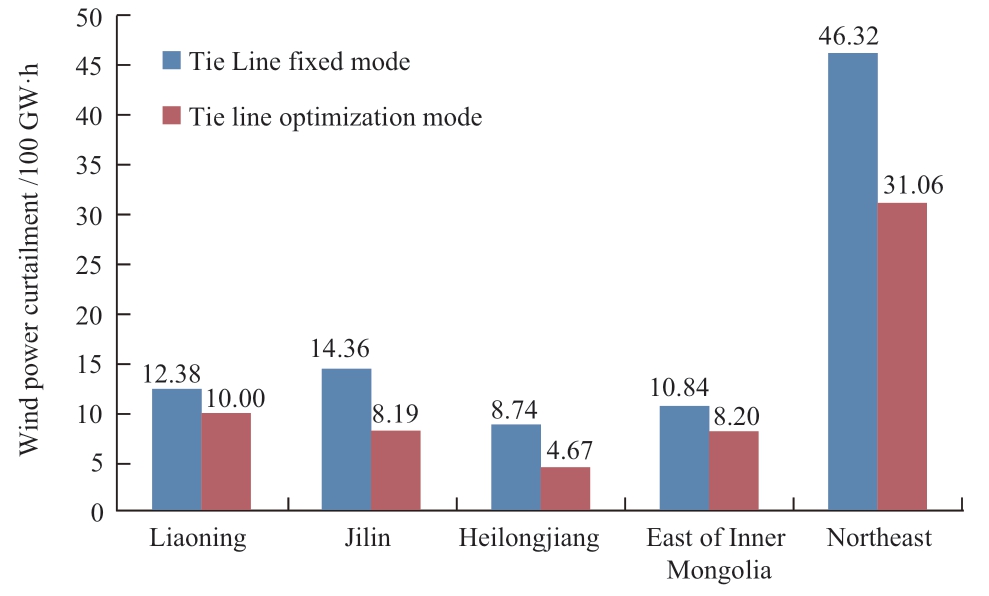
Fig.7 Comparison of wind power curtailments in Northeast China under different modes
4.2 Promote multi-energy complementarity and flexible power regulation
High proportion of renewable energy accommodation can be achieved through intelligent dispatch and control of power system, multi-energy complementarity and coordinated utilization.The first is to use the storage and regulation capabilities of multiple types of energy such as water, heat, electricity, etc., to improve the flexibility, adjustability, economy, safety, and intelligence of various grid-connected power supplies.The second is to improve the operation flexibility of thermal power units to cope with the fluctuation and instability of large-scale renewable energy power generation[18,19].Considering a provincial power grid as an example, by improving the thermal power-unit regulation capability, the minimum technical output of the thermal power unit will be reduced from 60% to 50%, 40%, 30% and 20%, respectively, which can increase the wind power accommodation of the region by 7.6 TW·h, 14.5 TW·h, 19.7 TW·h, and 23.9 TW·h, respectively, and increase solar renewable power accommodation by 3.5 TW·h, 6.4 TW·h, 8.4 TW·h, and 10.2 TW·h, respectively.Fig.8 compares the power curtailments.Therefore, the flexibility retrofit of thermal power units can significantly improve the capacity of renewable energy accommodation.
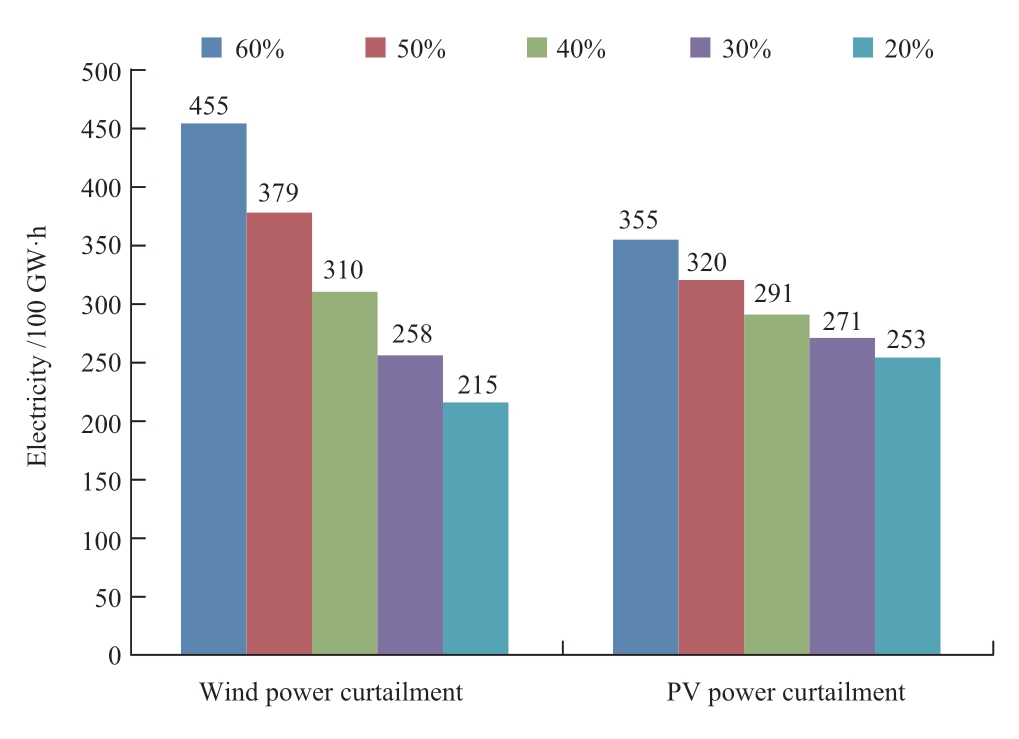
Fig.8 Comparison of renewable power curtailments under the different minimal output of thermal power unit
4.3 Electricity substitution and demand response
In the terminal energy consumption segment, the substitution of electricity in the fields of residence, industrial and agricultural production, and transportation is actively promoted.By developing electric vehicles, replacing coal, firewood, and transportation fuels with electricity, and developing heat-power decoupling, ground source heat pumps, waste heat utilization, electric cooking, industrial electric boiler, agricultural electric irrigation and drainage, etc., the share of electricity in end-user energy demand is growing, which will further facilitate the development and accommodation of renewable energy [20].Calculation results indicate that a province can increase wind power accommodation by 500 GW·h through replacing 4 TW·h end-user energy consumption with electricity, and the wind curtailment rate is reduced by 3.2%.By strengthening the intelligent management of the power demand side, using the power market mechanism and flexible electricity price policy to guide users to change their electricity habits and improve load characteristics, the utilization of renewable energy power generation can be effectively promoted.In provinces (autonomous regions) with a large installed capacity of renewable energy, through smart power utilization technology, the coordination between renewable energy power generation and power load is improved.Incentive mechanisms like peak and offpeak electricity prices, time-of-use electricity prices, and real-time electricity prices are used to encourage generationside peak shaving, user-side energy saving and off-peak power consumption.With this contribution, user-side virtual peak shaving can be achieved through the shifting, interruption, and adjustment of partial load, which improves the flexibility and economy of power system, and reduces the user’s electricity cost as well.To compare the wind power curtailments under different demand modes, the simulation is conducted with the operation data of a provincial power grid, where the total daily load electricity remains constant, and the peak load is shiftable (the maximum daily load shifting electricity is 10% of the daily average load electricity, and the maximum load shifting at each time is 10% of the maximum load).As shown in Fig.9, the wind power curtailment rate can be reduced by 4.1%.The demand response and intelligent regulation are a few of the important approaches to improve the capability to accommodate renewable energy.
4.4 R&D and promotion of large-capacity low-cost energy storage technology
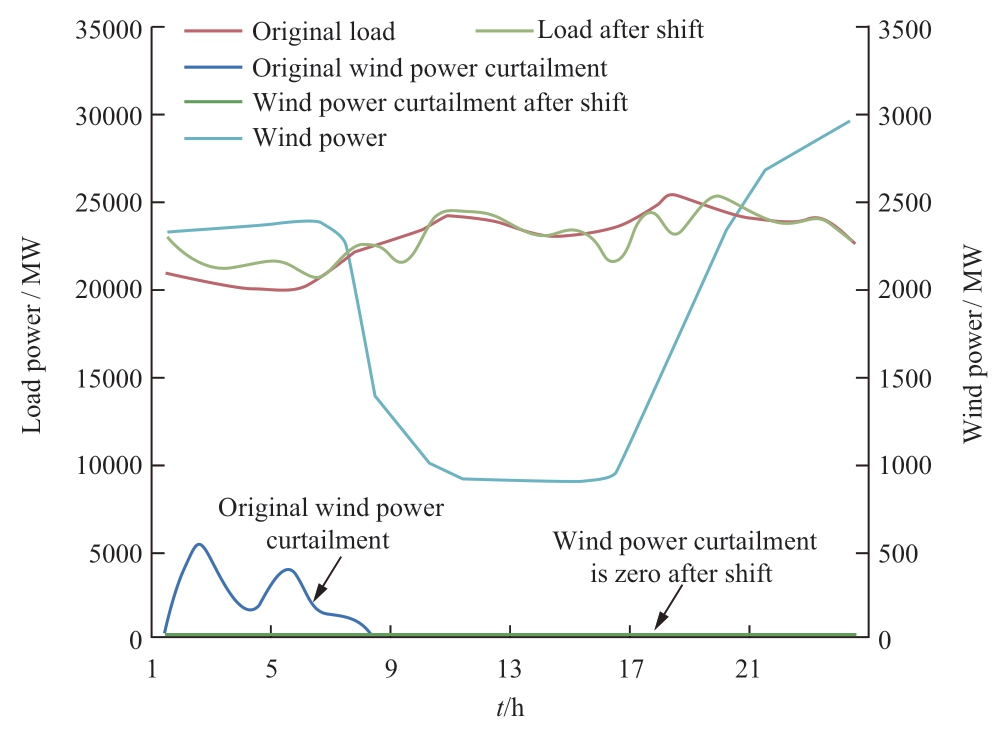
Fig.9 Comparison of wind curtailments under different demand modes
The application of large-scale energy storage technology can improve the flexibility of the power system operation and the accommodation capacity of the renewable energy.Research and development of various storage technologies such as energy storage, heat storage, cold storage, gas storage, hydrogen production and storage of other energy-carrying materials satisfy the requirements of multiple application scenarios in different stages of power generation, transmission, distribution and consumption.Future energy storage technologies will be developed in the direction of high energy and power density, low cost, as well as high safety and reliability.High-capacity, low-cost energy storage battery technology will be widely used in the field of renewable energy grid integration [22].
The impact of energy storage on wind power accommodation is shown in Fig.10.The simulation of a provincial power grid in 2016 shows that by installing 600 MW × 6 h energy storage equipment, the wind power accommodation capacity of 400 GW·h can be improved throughout the year and the wind curtailment rate can be reduced by 3%.
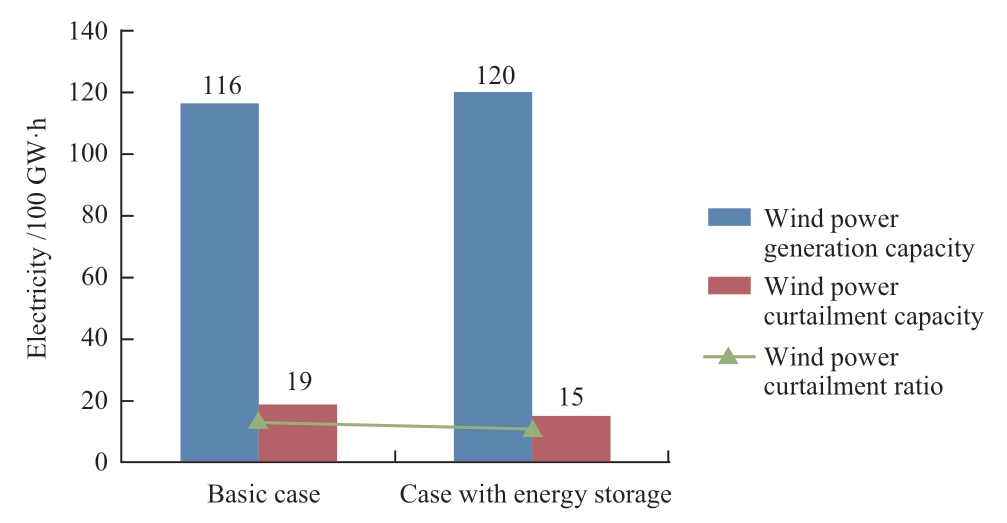
Fig.10 Effect of energy storage on wind power accommodation
4.5 Building a more efficient power market
The interconnected and resource sharing smart grid can effectively support a large-scale power market.Such smart grid will be an important platform for realizing efficient utilization and full accommodation of renewable energy.According to the type of transaction, the power market mechanism related to renewable energy accommodation in China can be divided into electricity trading and generation rights/replacement trading.The former can be divided into peaking auxiliary service market and cross-regional renewable energy direct transaction; the latter can be divided into inter-provincial reserve and generation sharing transaction, enterprise owned power plant/thermal power plant replacement transaction, cross-regional renewable energy and thermal power replacement transaction.Under the national unified market framework, renewable energy of China will mainly participate in the inter-provincial medium and long-term transactions to achieve large-scale optimal allocation of resources through the participation of the electricity market.Flexible short-term trading will eliminate the grid peak shaving problem caused by the volatility of renewable energy.The market will gradually transform into a complete market system including the medium and long-term market and the spot market, to achieve priority accommodation by utilizing the low marginal cost of renewable energy.
The real-time power market can use modern information and communication technologies such as cloud computing, big data, mobile communications, and the Internet of Things to intelligently judge the curtailment of wind, solar, and water conditions, and timely adjust and release real-time electricity prices.
Through the power market mechanism (including the grid auxiliary service market), the participants are encouraged to actively use the surplus, off-peak, and curtailment electricity.Furthermore, the zero or negative electricity price mechanism and the auxiliary services of the power market can make users consciously adapt to the fluctuation of renewable energy themselves, adjust the habit of using electricity, and obtain the benefits.
5 Insights and suggestions for GEI from China renewable energy development
5.1 Drivers of Global Energy Interconnection development
In November 2016, the Paris Agreement came into effect, making that the accelerating clean development, tackling climate change, and promoting world energy transformation become a consensus and common action worldwide.From the perspective of power generation, the global renewable energy (water, wind, solar, etc.) resources are very rich, of which the theoretical reserves of wind and solar resources are approximately 0.2×107 TW·h and 1.5×108 TW·h.It is 38 times the total amount of remaining proven recoverable reserves of global fossil energy, and only exploiting five-thousandths of them can satisfy global energy requirements [1,23].Developing renewable energy and sharing clean resources are important drivers for building the GEI.In the future, renewable energy will become more prominent in the global energy supply.By 2050, renewable energy is estimated to satisfy more than 50% of the primary energy demands worldwide [24].From the perspective of electricity consumption, the global distribution of electricity consumption per capita is extremely uneven, which has become an important factor restricting the balanced development of the global economy.According to the 2016 statistics, the annual per capita electricity consumption in North America and Northern Europe is more than 1000 kW·h, and the Central African and South Asian countries are below 500 kW·h, while some countries are less than 100 kW·h.Approximately 1.2 billion people have no access to electricity [25].The global endowment of renewable energy resources is similar to that in China.Most renewable energyrich areas and load-concentrated areas are inversely distributed, so it is necessary to take the way of centralized development and long-distance transportation to the load center for utilization.Only in some areas, renewable energy resources and load are well matched, and local development and local utilization can be adopted.GEI is a “giant system” aimed at the co-construction, sharing, interconnection, and openness of energy resources.It is a development platform that creates comprehensive values of economy, society, environment, and ecology and will profoundly change global energy development, economic growth, social life, and ecological environment, bringing about fundamental changes in productivity and production relations in the energy sector [25].
5.2 Foundation for Global Energy Interconnection development
In terms of resource reserves, non-water renewable energy bases worldwide are mainly distributed in the zigzag area consisting of Arctic wind power, equatorial solar energy, and 45° energy belt.In terms of renewable energy power generation technology and power market, Denmark, the United Kingdom, Germany, Spain, and China have had many successful experiences.In terms of equipment manufacturing and industrial conditions, relying on technological advancement and overall production chain efficiency improvement, global wind power and photovoltaic power generation costs have continued to decline in recent years.The average cost per kW·h of global onshore wind power in 2018 decreased by 67% compared with the cost of 2009, whereas the average cost per kW·h of photovoltaic power decreased by 86%.
In terms of UHV transmission technology, UHV AC and DC transmission are being applied in more networking projects as a mature transmission technology from a global perspective.
In terms of mechanism and planning, a series of smart gridrelated innovative development plans and policy measures were launched globally in 2016, such as Energy and Environment Technology Innovation Strategy 2050 and Energy Technology Revolution Innovation Action Plan (2016~2030), providing a guideline to accelerate energy technology innovation.Countries such as the United States and Australia have released new blueprints for developing power systems and setting new plans for developing smart grids.
In November 2017, the GEI Development Cooperation Organization released the Global Energy Internet Action Plan for Implementing the UN 2030 Agenda for Sustainable Development at the UN High-Level Symposium, and proposed ten actions, including promoting concepts, clean development, eliminating no electricity, grid interconnection, energy replacement, smart grid, energy efficiency improvement, innovation-driven, capacity building and policy assurance and five major mechanisms, including global power planning, multinational engineering, global power trading, the interconnection grid coordination and technical standards coordination, to implement the 2030 Agenda based on the GEI.The action plan laid the foundation for promoting the strategic planning and construction of the GEI [10].
5.3 Insights from the development of renewable energy in China
In summary, China’s renewable energy development contributes the following main insights for building GEI:
(1) Establish the GEI based on clean renewable energy and a multi-energy view of synergistic, complementary, and mutually beneficial development of various types of energy.
(2) Strengthen cooperation in global technical standards in areas such as UHV transmission, smart grid, clean energy, energy storage, and large-scale grid operation control, to promote advanced technologies and innovations[26].
(3) Actively promote a more balanced and more flexible power market with more countries (regions) participate in, achieving renewable energy power accommodation and mutual benefit.Accelerate the progress on universal access to electricity, whereas turning the resource advantages of developing countries into economic society developing advantages to promote the coordinated development of global energy, power, economy, and society.
(4) In accordance with the three-step development path of domestic interconnection-intracontinental interconnection-intercontinental interconnection, we intend to promote mature UHV AC and DC transmission technologies and distributed microgrid technologies globally, develop clean energy and build power grids according to the requirements of local countries, and consider relevant country’s laws, standards, technology, environmental protection, engineering construction, operations and other issues, first with demonstration projects, to build the GEI in order.
6 Conclusion
To protect global energy security, address climate change, and achieve sustainable human, social and ecological development, a renewable energy-led power supply system should be established.
China has achieved world-renowned achievements in using renewable energy, leading the world in terms of UHV transmission and smart grid technology.Based on the analysis of the experience and challenges of renewable energy development, China further clarified the development goals and major initiatives in renewable energy field.
The world is rich in renewable energy resources, and a vigorous development of renewable energy has become a global demand and strategy.Building the GEI is of paramount importance to help develop global renewable energy and provide clean energy.The experience of China and the achievements in the exploration of renewable energy resources, development models, UHV transmission technology, strong smart grid construction, and policy standards can provide reference and inspiration for the future GEI construction.
References
[1] Liu Z.Global (2015) Energy Interconnection[M].Beijing:China Electric Power Press, 199-254(in Chinese)
[2] EPIA.Global market outlook for photovoltaics 2014-2018 [R].2014
[3] IEA.World energy outlook 2015[R].2015
[4] Wang Y (2016).Concept and prospect of global energy interconnection [J].Electric Power, 49(3):1-5(in Chinese)
[5] Tang G, He Z, Pang H (2016) Discussion on applying the VSCHVDC technology in global energy Interconnection [J].Smart Grid, 2: 116-123(in Chinese)
[6] Zeng M, Yang Y, Liu D, et al (2016) “ Generation-Grid-Load-Storage” coordinative optimal operation mode of energy internet and key technologies [J].Power System Technology, 1(40): 114-124(in Chinese)
[7] Shu Y, Zhang Z, Guo J, et al (2017) Study on key factors and solution of renewable energy accommodation [J].Proceedings of the CSEE, 37(1): 1-8(in Chinese)
[8] Liu Z, Zhang Q (2013).Study on the development mode of national power grid of China [J].Proceedings of the CSEE, 33(7): 1-10(in Chinese)
[9] Zhao L, Bai J, Xin S, et al (2016) Study on development path of renewable energy in China [J].Electric Power, 01(49): 178-184(in Chinese)
[10] Global Energy Interconnection Development and Cooperation Organization.Development and Outlook of Global Energy Interconnection 2017 [R].2017
[11] China Electricity Council.List of basic data of electricity statistics in 2018[EB/OL].http://www.cec.org.cn/guihuayutongji/tongjxinxi/niandushuju/2020-01-21/197086.html(in Chinese)
[12] State Grid Corporation of China.State Grid Corporation of China promoting new energy development white paper 2018 [R].2018(in Chinese)
[13] State Grid Corporation of China.Corporate social responsibility report 2018 [R].2018(in Chinese)
[14] IRENA.Renewable capacity statistics 2019 [R].2019
[15] Liu Z, Zhang Q, Dong C, et al (2014) Efficient and security transmission of wind, photovoltaic and thermal power of largescale energy resource bases through UHVDC projects [J].Proceedings of the CSEE, 34(16): 2513-2522(in Chinese)
[16] State Grid Energy Research Institute Co.LTD.Analysis Report of New Energy Power Generation 2019 [M].Beijing: China Electric Power Press, 2019(in Chinese)
[17] Liu Z, Zhang Q, Dong C, et al (2014) Efficient and security of wind, photovoltaic and thermal Power of Large-scale energy resource bases through UHVDC projects [J].Proceedings of CSEE, 34(16): 2513-2522(in Chinese)
[18] Lu Z, Li H, Qiao Y (2017), Flexibility evaluation and supply/demand balance principle of power system with high-penetration renewable electricity [J].37(1): 9-19(in Chinese)
[19] Liu J, Zeng D, Tian L, et al (2015).Control strategy for operating flexibility of coal-fired power plants in alternate electrical power systems [J].Proceedings of the CSEE, 35(21): 5385-5394(in Chinese)
[20] Zhang Y, Lu G, Wang P, et al (2020) Analysis on the improvement path of non-fossil energy consumption proportion and terminal electrification rate under the new energy security strategy [J].Electric Power, 2020(in Chinese)
[21] Shen Y, Li Y, Gao C, et al (2017) Application of demand response in ancillary service market [J].Automation of Electric Power Systems, 41(22): 151-161(in Chinese)
[22] Hu J, Huang B, Jiang L, et al (2020) Application and major issues of electrochemical energy storage under the environment of power market [J].Electric Power, 53(1): 100-107(in Chinese)
[23] WEC.World energy scenarios: composing energy futures to 2050[R].2013
[24] EU.Energy road map 2050 [R].2012
[25] Global Energy Interconnection Development and Cooperation Organization.Global Energy Internet Development Strategy White Paper 2017 [R].2017
[26] Zhou X, Chen S, Lu Z (2013).Review and prospect for power system development and related technologies: a concept of threegeneration power systems [J].Proceedings of the CSEE, 36(22): 1-11(in Chinese).
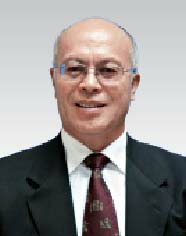

Scan for more details
Received: 30 October 2019/ Accepted: 5 December 2019/ Published: 25 February 2020
 Qili Huang
Qili Huang
huangqilispnec@sina.com
Most of the “China” in this paper refer to “mainland China”, except the words in the law’s name, company name, geographical names, and journal names.
2096-5117/© 2020 Global Energy Interconnection Development and Cooperation Organization.Production and hosting by Elsevier B.V.on behalf of KeAi Communications Co., Ltd.This is an open access article under the CC BY-NC-ND license (http: //creativecommons.org/licenses/by-nc-nd/4.0/ ).
Biography
Qili Huang is an academician of the Chinese Academy of Engineering, State Grid Corporation Consultant.He received his Ph.D.degree from Ho kkaido University, Japan in 1987.His research interests include clean coal and highefficiency power generation, renewable energy generation, energy conservation, environmental protection and energy development strategy, etc.
(Editor Zhou Zhou)
